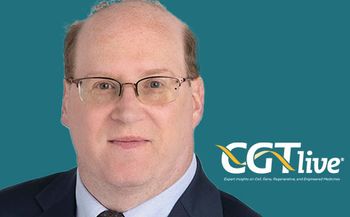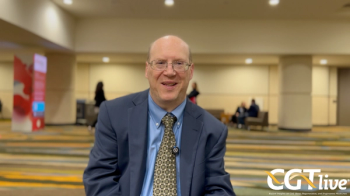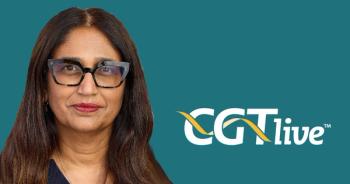
Making the Case for Earlier CAR T-Cell Therapy in Lymphoma
Real-world data on the use of chimeric antigen receptor T-cell therapy in large B-cell lymphoma bear out the pivotal results from ZUMA-1 and demonstrate not only that the treatment approach is here, but also that it’s time to address issues of efficacy, safety, cost, and moving this approach into earlier lines of therapy.
Frederick L. Locke, MD
Real-world data on the use of chimeric antigen receptor (CAR) T-cell therapy in large B cell lymphoma bear out the pivotal results from ZUMA-1 and demonstrate not only that “CAR T-cell therapy is here,” but also that it’s time to address issues of efficacy, safety, cost, and moving this approach into earlier lines, said Frederick L. Locke, MD, at the 23rd Annual International Congress on Hematologic Malignancies®.1
Early results of a real-world population study showed that the use of axicabtagene ciloleucel (axi-cel; Yescarta) CD19-targeted CAR T-cell therapy produced a median progression-free survival (PFS) of 6.18 months (95% CI, 4.57-NA) in patients with relapsed/refractory large B-cell lymphoma versus 5.8 months for ZUMA-1 patients (95% CI, 3.3-NE).
“The PFS curves are starting to look very similar,” said Locke, who leads the Immune Cell Therapy (ICE-T) initiative, as well as clinical research in CAR T-cell therapy at Moffitt Cancer Center. The respective objective response rates (ORRs) from the multicenter real-world study were 79% by day 30 and 82% overall.2
Currently, Locke said, patients relapsing on R-CHOP for non-Hodgkin lymphomas are typically referred for CAR T-cell therapy only after second relapse and a second course of chemotherapy or autologous stem cell transplant. Cure rates are better with CAR T-cells in the third-line (15%) than they are with second-line chemotherapy or ASCT (around 5%), which is an argument for moving this approach earlier in the treatment path, he said, noting the tendency for rapid relapse in aggressive lymphoma.
“I personally believe that a patient who has progressed on R-CHOP therapy should have a referral for CAR-T cell therapy,” said Locke. “They’re not [currently] eligible on second-line. They may be eligible for a clinical trial. However, it takes time to set up CAR T-cell therapy, and if a patient doesn’t respond to second-line therapy, you need to be ready to go.”
Randomized trials such as the phase III ZUMA-7 are comparing CD19-targeted CAR T-cell therapy with second-line standard of care for relapsed/refractory diffuse large B-cell lymphoma (DLBCL).
Data on safety for CAR T cells make it difficult to compare across trials and between patients with lymphoma and other disease types, Locke said. For example, for adult DLBCL, bridging chemotherapy was allowed in the JULIET trial of tisagenlecleucel (Kymriah) CAR T-cell therapy (92% of patients) whereas it was not permitted in the ZUMA-1 (0%) trial of axi-cel. Grade ≥3 cytokine release syndrome (CRS) occurred in 22% and 13% of patients, respectively, and the overall rate of CRS also differed: 58% versus 93%.
Locke noted that Novartis has led an effort to regrade JULIET toxicities by international criteria and, similarly, in January 2019, the American Society for Blood and Marrow Transplantation published on its effort to harmonize definitions and grading systems for CRS and neurotoxicity with respect to CAR T-cell therapy.3
Future efforts should be directed to the study of late complications of CAR T-cell therapy and standardization of management, such as how to address B cell depletion, hypogammaglobulinemia, cytopenia, and infections.
“These patients can have hypocellular bone marrows, no evidence of dysplasia, but continue to have cytopenia,” Locke said. “We’re able to manage those patients in general, but we need to handle that better.” Deciding whether or not to vaccinate and whether patients respond to vaccinations are other open issues, he added.
In the phase II portion of ZUMA-1, 43% of patients received tocilizumab (Actemra) and 27% received steroids, and CRS and neurologic events (NEs) were generally reversible, Locke said. “We started to realize that the use of these agents—tocilizumab and steroids—did not preclude long durations for these patients, so we actually changed the guidelines and started giving those treatments earlier,” Locke said.
In ZUMA-1, the prophylactic value of tocilizumab to reduce the incidence of severe CRS and NEs was prospectively evaluated, with tocilizumab given on day 2 following infusion with axi-cel. The finding was that tocilizumab reduced severe CRS but not severe NEs. In a safety management study cohort (n = 34), 1 patient (3%) experienced a grade ≥ 3 CRS, and 14 (41%) experienced a grade ≥ 3 NE.
Prophylactic tocilizumab decreased serum C-reactive protein, increased serum IL-6, but did not influence CAR T-cell numbers; and in patients who developed grade ≥ 3 or higher NEs, cerebrospinal fluid on day 5 of treatment revealed increased CD14-positive myeloid cells and predominantly CD4-positive CAR T cells.
In ZUMA-1, 3 biomarkers were associated with severe NEs but not severe CRS: IL-2, GM-CSF, and blood ferritin.
Moreover, parotid tumor biopsies in ZUMA-1 given before and during treatment indicated elevations of key checkpoint molecules, including CTLA-4 and PD-1, “and so, something’s happening inside the patient’s tumors,” Locke said.
In ZUMA-6, a trial of axi-cel and atezolizumab (Tecentriq) for DLBCL, patients were given the PD-1 inhibitor at day 21 after CAR T-cell therapy. Evidence suggests atezolizumab may increase CAR T-cell levels and persistence, with no significant effect on serum cytokine levels. Also, delayed radiographic responses were seen. The ORR was 92% (11/12 patients); complete response (CR) was 58% (7/12); and toxicity was similar to that observed in ZUMA-1.
Locke briefly discussed the adult (CALM) and pediatric (PALL) studies of UCART19, an allogeneic CAR T-cell product in which the TRAC and CD52 genes have been knocked out to facilitate acceptance. The UCART19 data have shown an acceptable safety profile, and 82% of those treated with a lymphodepleting regimen achieved CR or CR with incomplete hematological recovery.
Especially in lymphoma, a successful “off the shelf” CAR T-cell product would be of great value given that time is critical, Locke said. “This could be a game-changer if it’s safe and effective to the degree that we have in autologous CAR T-cells, because if we could quickly give the patient a CAR T-cell within a day or a week, that is really going to make a difference rather than waiting 3 or 4 weeks for them to be manufactured, which is too late. We can’t wait another 4 weeks for those patients.”
References
- Locke FL. What is next for CAR T cells? Presented at: 23rd Annual International Congress on Hematologic Malignancies®; February 28-March 1, 2019; Miami Beach, FL.
- Nastoupil LJ, Jain MD, Spiegel JY, et al. Axicabtagene ciloleucel (axi-cel) CD19 chimeric antigen receptor (CAR) T-cell therapy for relapsed/refractory large B-cell lymphoma: real world experience. Presented at: 2018 ASH Annual Meeting; December 1-4, 2018; San Diego, CA. Abstract 91. ash.confex.com/ash/2018/webprogram/Paper114152.html.
- ASBMT releases paper on consensus grading for IEC toxicities [press release]. American Society for Blood and Marrow Transplantation website. Published January 1, 2019. www.asbmt.org/blogs/content-administrator/2019/01/08/asbmt-paper-consensus-grading-for-iec-toxicities. Accessed March 1, 2019.
Newsletter
Stay at the forefront of cutting-edge science with CGT—your direct line to expert insights, breakthrough data, and real-time coverage of the latest advancements in cell and gene therapy.

















































